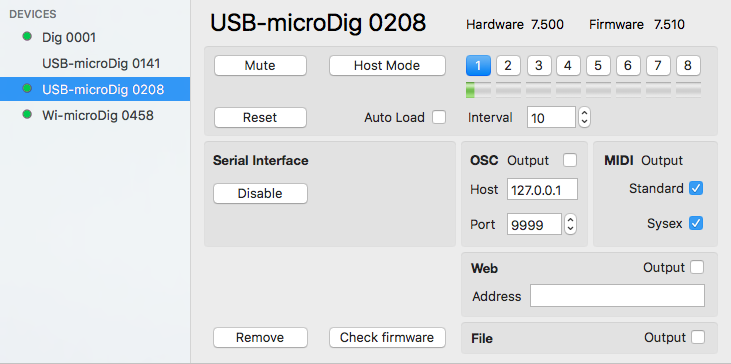Difference between revisions of "Connect-160 macos QuickStart USB-microDig"
| Line 15: | Line 15: | ||
| − | ==Connecting the USB-microDig== | + | ==Connecting to the USB-microDig== |
Connect the USB-microDig to a USB port on your Mac and I-CubeX Connect will automatically create a virtual MIDI port for it. | Connect the USB-microDig to a USB port on your Mac and I-CubeX Connect will automatically create a virtual MIDI port for it. | ||
Revision as of 16:44, 12 December 2018
Connect runs in the background and can be accessed via the menu bar at the top of the screen. When a USB-microDig is plugged in Connect creates a virtual MIDI port with the name and serial number of that device.
Installing the USB-microDig
On both Windows and MacOS, you'll first need to add the USB-microDig as a virtual serial (or COM) port by installing its SiliconLabs driver.
The drivers were installed correctly if the connected USB-microDig is listed in System Report (under About this Mac), in the USB section under Hardware. There should be an entry "I-CubeX USB-microDig".
On MacOS Sierra or higher, make sure to allow the driver extension in the "Security & Privacy" panel of the System Preferences, within 30 minutes after installation (or else re-install the drivers if MacOS doesn't show a way to allow the driver).
Connecting to the USB-microDig
Connect the USB-microDig to a USB port on your Mac and I-CubeX Connect will automatically create a virtual MIDI port for it.
On USB-microDigs with firmware 7.2 or newer the yellow and green LEDs on the USB-microDig will blink briefly. If it was in host mode the blinking of both green and yellow LEDs will stop. On USB-microDigs with firmware 7.1 or older the red power LED will stop blinking to indicate that it is enabled.
In Connect, a green dot will appear next to the device in Connect's digitizer view window.
The USB-microDig will also appear in the pull down menu. If Connect was successful in communicating with it, it should be enabled and it will be listed in the main menu with a bullet ("•") preceding its name. You can view the device's settings by clicking on its name in the main menu.

